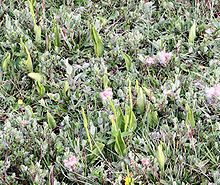Ophioglossum vulgatum
| Ophioglossum vulgatum | |
|---|---|

| |
| Scientific classification | |
| Kingdom: | Plantae |
| Clade: | Tracheophytes |
| Division: | Polypodiophyta |
| Class: | Polypodiopsida |
| Order: | Ophioglossales |
| Family: | Ophioglossaceae |
| Genus: | Ophioglossum |
| Species: | O. vulgatum
|
| Binomial name | |
| Ophioglossum vulgatum | |
Ophioglossum vulgatum, commonly known as adder's-tongue,[1] southern adder's-tongue or adder's-tongue fern, is a species of fern in the family Ophioglossaceae.[2]
The chloroplast genome was reported to have a size of 138,562 base pairs.[3]
Description
[edit]Ophioglossum vulgatum grows from a rhizome base to 10–20 cm tall (rarely to 30 cm).[citation needed] It consists of a two-part frond, separated into a 4-12 cm rounded diamond-shaped leaf sheath and narrow branchless spore-bearing spike.[4] The spike has around 10-40 segments on each side.[citation needed]
It reproduces by means of spores.[4]
Taxonomy
[edit]Linnaeus described adder's-tongue with the binomial Ophioglossum vulgatum in his Species Plantarum of 1753.[5]
Distribution
[edit]It is native to many regions with a wide scattered distribution: throughout temperate through tropical Africa and throughout the temperate Northern Hemisphere in Europe, northeastern North America, temperate Asia, and Eurasia.[2][6]

Habitat
[edit]This small, hard-to-spot plant can occur singly in unimproved pastures, rock crevices and grassy path-sides, but also can occur in colonies of hundreds of plants in sand dunes.[citation needed]
In Finland, unlike elsewhere, it grows on seashores, unlike other parts of the world where it tends to be a calciphile. Finland has fitting lime rich soil habitat sparsely, but the plant has found an equivalent living habitat from Finland's seashores affected by a post-glacial rebound: land just risen from the sea is often quite neutral and cointains mineral salts in addition to being open and bare enough.[4]
Rarity
[edit]This species is rare in most European countries. In Ukraine, there were recorded 280 loci: 152 before 1980, after 1980 – 120, as before and after 1980 – 8 locations.[7]
Uses
[edit]Traditional European folk use of leaves and rhizomes as a poultice for wounds. This remedy was sometimes called the "Green Oil of Charity". A tea made from the leaves was used as a traditional European folk remedy for internal bleeding and vomiting.[8]
References
[edit]- ^ Stace, Clive (2010b), New Flora of the British Isles (3rd ed.), Cambridge, UK: Cambridge University Press, ISBN 978-0-521-70772-5, p. 9
- ^ a b "Ophioglossum vulgatum". Germplasm Resources Information Network. Agricultural Research Service, United States Department of Agriculture. Retrieved 2014-02-14.
- ^ Hao, J., Liang, Y., Zhu, M., Ping, J., Feng, P., Su, Y., & Wang, T. (2021). The complete chloroplast genome of Ophioglossum vulgatum L.(Ophioglossaceae) and phylogenetic analysis. Mitochondrial DNA Part B, 6(9), 2730-2731.
- ^ a b c Piirainen, Mikko; Piirainen, Pirkko; Vainio, Hannele (1999). Kotimaan luonnonkasvit [Native wild plants] (in Finnish). Porvoo, Finland: WSOY. p. 26. ISBN 951-0-23001-4.
- ^ Linnaeus, C. (1753). Species Plantarum. Vol. II (1st ed.). Stockholm: Laurentii Salvii. p. 1062.
- ^ USDA
- ^ Parnikoza I., Celka Z. An Archive of the Ophiglossaceae in Ukraine
- ^ "Dr. Duke's Phytochemical and Ethnobotanical Databases at NAL". 2023-02-03. Archived from the original on 2023-02-03. Retrieved 2024-04-17.
6. [1]

